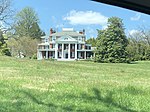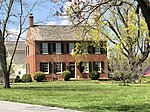Patuxent River State Park
1963 establishments in MarylandParks in Howard County, MarylandParks in Montgomery County, MarylandProtected areas established in 1963State parks of Maryland ... and 1 more
Use mdy dates from August 2023

Patuxent River State Park is a public recreation area located along the upper reaches of the Patuxent River in Howard and Montgomery counties in Maryland. The state park features hunting, fishing, mountain biking, horseback riding, and hiking on unsigned and untended trails. Planning for the park began in 1963, with the Maryland General Assembly funding land purchases in each year from 1964 to 1968. It is part of the Northeastern coastal forests ecoregion.
Excerpt from the Wikipedia article Patuxent River State Park (License: CC BY-SA 3.0, Authors, Images).Patuxent River State Park
Geographical coordinates (GPS) Address Website Nearby Places Show on map
Geographical coordinates (GPS)
| Latitude | Longitude |
|---|---|
| N 39.259444444444 ° | E -77.081388888889 ° |
Address
Montgomery County (Montgomery)
Maryland, United States
Open on Google Maps


